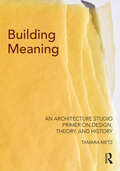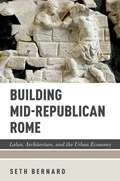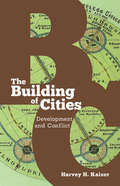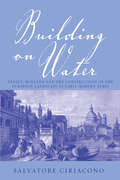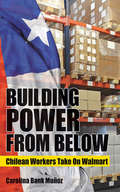- Table View
- List View
Building Magic: Ritual and Re-enchantment in Post-Medieval Structures (Palgrave Historical Studies in Witchcraft and Magic)
by Owen Davies Ceri HoulbrookThis book redresses popular interpretations of concealed objects, enigmatically discovered within the fabric of post-medieval buildings. A wide variety of objects have been found up chimneybreasts, bricked up in walls, and concealed within recesses: old shoes, mummified cats, horse skulls, pierced hearts, to name only some. The most common approach to these finds is to apply a one-size-fits-all analysis and label them survivals and apotropaic (evil-averting) devices. This book reconsiders such interpretations, exploring the invention and reinvention of traditions regarding building magic. The title Building Magic therefore refers to more than practices that alter the fabric of buildings, but also to processes of building magic into our interpretations of the enigmatic material evidence and into our engagements with the buildings we inhabit and frequent.
Building Meaning: An Architecture Studio Primer on Design, Theory, and History
by Tamara MetzBuilding Meaning: An Architecture Studio Primer on Design, Theory, and History is an essential introduction to the complex relationship between form making, historical analysis, and conceptual explorations. This book focuses on the relationship and interdependence between design, theory, and history for an innovative and holistic studio approach. Rather than suggest a singular narrative, this book draws from a diverse range of thinkers and designers to highlight the many interpretations of key architectural concepts, and provides readers with the context essential for developing their own approaches to any design problem. Building Meaning is organized to reflect the typical studio process, with stand-alone chapters that provide flexibility for use at any stage of design. The ideal book for beginning and intermediate architecture students, it gives specific methods to apply in the studio to make the most of the design process, as well as focused exercises to creatively explore each concept presented. Illustrated with more than 250 color images, it enables readers to engage and understand critically the genesis of architectural ideas and their role in our social and cultural experience.
Building Meaning: An Architecture Studio Primer on Design, Theory, and History
by Tamara MetzBuilding Meaning: An Architecture Studio Primer on Design, Theory, and History is an essential introduction to the complex relationship between form making, historical analysis, and conceptual explorations. This book focuses on the relationship and interdependence between design, theory, and history for an innovative and holistic studio approach. Rather than suggest a singular narrative, this book draws from a diverse range of thinkers and designers to highlight the many interpretations of key architectural concepts, and provides readers with the context essential for developing their own approaches to any design problem. Building Meaning is organized to reflect the typical studio process, with stand-alone chapters that provide flexibility for use at any stage of design. The ideal book for beginning and intermediate architecture students, it gives specific methods to apply in the studio to make the most of the design process, as well as focused exercises to creatively explore each concept presented. Illustrated with more than 250 color images, it enables readers to engage and understand critically the genesis of architectural ideas and their role in our social and cultural experience.
Building Mid-Republican Rome: Labor, Architecture, and the Urban Economy
by Seth BernardBuilding Mid-Republican Rome offers a holistic treatment of the development of the Mid-Republican city from 396 to 168 BCE. As Romans established imperial control over Italy and beyond, the city itself radically transformed from an ambitious central Italian settlement into the capital of the Mediterranean world. Seth Bernard describes this transformation in terms of both new urban architecture, much of it unprecedented in form and extent, and new socioeconomic structures, including slavery, coinage, and market-exchange. These physical and historical developments were closely linked: building the Republican city was expensive, and meeting such costs had significant implications for urban society. Building Mid-Republican Rome brings both architectural and socioeconomic developments into a single account of urban change. Bernard, a specialist in the period's history and archaeology, assembles a wide array of evidence, from literary sources to coins, epigraphy, and especially archaeological remains, revealing the period's importance for the decline of the Roman state's reliance on obligation and dependency and the rise of slavery and an urban labor market. This narrative is told through an investigation of the evolving institutional frameworks shaping the organization of public construction. A quantitative model of the costs of the Republican city walls reconstructs their economic impact. A new account of building technology in the period allows for a better understanding of the social and demographic profile of the city's builders. Building Mid-Republican Rome thus provides an innovative synthesis of a major Western city's spatial and historical aspects, shedding much-needed light on a seminal period in Rome's development.
Building Mid-Republican Rome: Labor, Architecture, and the Urban Economy
by Seth BernardBuilding Mid-Republican Rome offers a holistic treatment of the development of the Mid-Republican city from 396 to 168 BCE. As Romans established imperial control over Italy and beyond, the city itself radically transformed from an ambitious central Italian settlement into the capital of the Mediterranean world. Seth Bernard describes this transformation in terms of both new urban architecture, much of it unprecedented in form and extent, and new socioeconomic structures, including slavery, coinage, and market-exchange. These physical and historical developments were closely linked: building the Republican city was expensive, and meeting such costs had significant implications for urban society. Building Mid-Republican Rome brings both architectural and socioeconomic developments into a single account of urban change. Bernard, a specialist in the period's history and archaeology, assembles a wide array of evidence, from literary sources to coins, epigraphy, and especially archaeological remains, revealing the period's importance for the decline of the Roman state's reliance on obligation and dependency and the rise of slavery and an urban labor market. This narrative is told through an investigation of the evolving institutional frameworks shaping the organization of public construction. A quantitative model of the costs of the Republican city walls reconstructs their economic impact. A new account of building technology in the period allows for a better understanding of the social and demographic profile of the city's builders. Building Mid-Republican Rome thus provides an innovative synthesis of a major Western city's spatial and historical aspects, shedding much-needed light on a seminal period in Rome's development.
Building Networks: Exchange of Knowledge, Ideas and Materials in Medieval and Post-Medieval Europe (Themes in Contemporary Archaeology)
by Jeroen Bouwmeester Laura Patrick Duncan L. BerrymanThis book aims to explore different aspects of networks in relation to the archaeology of buildings. It is divided into three major themes: the trade in materials, the exchange of knowledge (of techniques and/or materials), and the exchange of style. Within each of these themes, two primary aspects are addressed—notably, who were the actors and how did the network function? In medieval and post-medieval Europe, the development of buildings, of style and the use of material, cannot be understood from a local, regional or even national perspective. Not only were the borders different than in modern-day Europe, but the contacts of inhabitants also transcended local and regional boundaries. This volume describes the continuous exchange of aesthetic ideals, technological developments and building materials during this period. This volume is a culmination of four years of sessions held at the European Archaeology Association (EAA) conference between 2016-2020 on the topic. It is of interest to archaeologists, architects, and scholars of built heritage.
Building New Labour: The Politics of Party Organisation
by M. Russell'New' Labour was defined in part by wide-ranging reforms to the party's internal democracy. These included changes to how candidates and leaders are selected, changes to policy making processes, and a programme of 'quotas' that transformed women's representation in the party. In the first book to analyse all these reforms in depth Meg Russell asks what motivated them, to what extent they were driven by leaders or members, and what they can teach us both about party organisational change and the nature of power relations in the Labour Party today.
Building/Object: Shared and Contested Territories of Design and Architecture
by Charlotte Ashby and Mark CrinsonBuilding/Object addresses the space in between the conventional objects of design and the conventional objects of architecture, probing and reassessing the differences between the disciplines of design history and architectural history Each of the 13 chapters in this book examine things which are neither object-like nor building-like, but somewhere in between – air conditioning; bookshelves; partition walls; table-monuments; TVs; convenience stores; cars – exposing particular political configurations and resonances that otherwise might be occluded. In doing so, they reveal that the definitions we make of objects in opposition to buildings, and of architecture in opposition to design, are not as fundamental as they seem. This book brings new aspects of the creative and experiential into our understanding of the human environment.
Building/Object: Shared and Contested Territories of Design and Architecture
Building/Object addresses the space in between the conventional objects of design and the conventional objects of architecture, probing and reassessing the differences between the disciplines of design history and architectural history Each of the 13 chapters in this book examine things which are neither object-like nor building-like, but somewhere in between – air conditioning; bookshelves; partition walls; table-monuments; TVs; convenience stores; cars – exposing particular political configurations and resonances that otherwise might be occluded. In doing so, they reveal that the definitions we make of objects in opposition to buildings, and of architecture in opposition to design, are not as fundamental as they seem. This book brings new aspects of the creative and experiential into our understanding of the human environment.
The Building of British Social Anthropology: W.H.R. Rivers and his Cambridge Disciples in The Development of Kinship Studies, 1898–1931 (Studies in the History of Modern Science #8)
by K. LanghamThe nature of that transition to maturity [a transition involving "The acquisition of the sort of paradigm that identifies challenging puzzles, supplies clues to their solution, and guarantees that the truly clever practitioner will succeed") deserves fuller discussion than it has received in this book, particularly from those concerned with the development of the contemporary social sciences. (Thomas S. Kuhn, 1969, Postscript to The Structure of Scientific Revolutions. ) The fIrst two or three decades of the twentieth-century represents a shadowy period in the history of science. For most contemporary scientists, the period is a little too far away to be the subject of a fIrst-hand oral tradition; while at the same time it is not suffIciently remote to have acquired the epic and oversimplifIed contour of history which has been transformed into mythol ogy. Historians of science, by contrast, who want to free themselves from the mythology which is used to legitimize the present state of the discipline, are interested in discovering what really happened, and how it was regarded at the time. For them the nature of science in the early twentieth-century is obscured by what they regard as its proximity in time, and they are disturbed by a general lack of depth in scholarly work in the area, which makes it diffI cult to see the period in proper perspective.
The Building of Chinese Ethnicity in Rome: Networks without Borders
by Violetta RavagnoliThis book presents the history of Chinese migrations to Europe within a “transcalar glocal” perspective. That is, it moves between international, national, and local levels of analysis to describe the different constraints Chinese migrants deal with in their lives. It problematizes and complicates ethnicity and identity and refers to controversial concepts like Roman-ness and Chinese-ness, used as identity signifiers. Ultimately, by presenting the lives of ethnic Chinese living in Italy in both global and local context, this book hopes to show the value of a "glocal" oral history of Chinese migrations.
The Building of Cities: Development and Conflict
by Harvey H. KaiserIn this classic book that records a moment in the history of urban planning, the architect and city planner Harvey H. Kaiser examines the city-building process from the time when a proposal for urban development is first conceived to the early stages of construction. Lysander (near Syracuse) and Gananda and Riverton (both near Rochester). These were brand-new developments and municipalities, and thus quite different from other trends of suburbanization that attached development onto existing municipalities. Step by step, he describes what happened in each of these communities during the presentation of the initial proposal, how parties interacted with each other, and how the climate of the community influenced the actions of the parties. Basing his work on hundreds of interviews, attendance at public meetings, and a review of many articles and documents, Kaiser shows that in each case the emergence of controversy and degree of acceptance was influenced by the developer's leadership, the characteristics of the developer's organization, and the method of presenting the proposal to the public. Kaiser brings to his comparative approach a background in the rough and tumble of day-to-day project management and the development of plans as well as their administration. The Building of Cities is an invaluable resource for developers, architects, public officials, and citizens involved in local government.
The Building of Civil Europe 1951–1972
by Stefanie PukallusThis book argues that early European Commission officials envisaged an integrated civil Europe from the outset. Largely overlooked is the fact that between 1951 and 1972 there was a group of European Commission (and before that the High Authority) officials who wished to build a Civil Europe to sit alongside an economic and political Europe. This Civil Europe was, it was hoped, to become home to a European citizenry equipped with a European civil consciousness that complemented their national and local loyalties. To this end these officials pioneered a series of civil initiatives designed to begin the process of building Civil Europe. This book analyses three such civil initiatives: the building of the first European School, the European Community’s participation in Expo 58 and the production of the European Community’s own documentaries. From the start Europe was designed and conceived of in terms of a European general civil public and not solely in terms dictated by economic and political interests.
Building on Water: Venice, Holland and the Construction of the European Landscape in Early Modern Times
by Salvatore CiriaconoA fundamental natural resource, water and its use not only reflect "modes of production" but also that complex interplay between resources and their exploitation (and domination) by various social agents, who in their turn are inevitably influenced by the abundance or rarity of water supplies. Focusing on scientific, social and economic issues from the 16th to the 19th century, the author, one of Italy's leading historians in this field, looks at the innumerable conflicts that arose over water resources and the environmental impact of projects intended to control them. Venice and Holland are undoubtedly the two most fascinating cases of societies "built on water," with the conquest of vast expanses of marshland - either inland or on the coast (the Dutch polders or the Venetian lagoon) – not only stimulating agricultural production, but also nurturing a deeply-felt relationship between the local populations and the element of water itself. The author rounds off his study by looking at the influence the hydraulic technology developed in Holland would have on many European countries (France, England and Germany in particular) and at questions raised by contemporaries about the environmental impact of agricultural progress and its effects upon the social-economic equilibria within the communities concerned.
Building Paradise: Episodes in Paradisiacal Thinking
by Harry Francis MallgraveA sweeping historical study, Building Paradise seeks to construct a garden ethic for the design arts. It is an ethic predicated on the idea that, with our recent ecological and biological insights, we can build more intelligently than the status quo of current design practices. The paradisiacal instinct is the motivation behind every artistic impulse. From its theological origins to the present, the idea of paradise—the garden as a place of peace, beauty, and happiness—has acquired numerous meanings. It was a motif expounded in the earliest cultures of Mesopotamia, Egypt, and the Indus Valley, and it later became a dominant feature of Buddhist, Judeo-Christian, and Islamic practices. It informed Greco-Roman mythologies and the design of a Japanese garden; it was a motivation for the Renaissance humanists, and was complicit in visions of a New Arcadia within the landscapes of the Americas. This book, underscoring how the built and urban environments shapes culture, takes a biophilic approach and draws upon the major advances of the human sciences of the last few decades to argue on behalf of a design ethic centered squarely on human needs and aspirations. Written for students and academics within architecture and all related fields, this book focuses on the efforts to build paradise in a material way.
Building Paradise: Episodes in Paradisiacal Thinking
by Harry Francis MallgraveA sweeping historical study, Building Paradise seeks to construct a garden ethic for the design arts. It is an ethic predicated on the idea that, with our recent ecological and biological insights, we can build more intelligently than the status quo of current design practices. The paradisiacal instinct is the motivation behind every artistic impulse. From its theological origins to the present, the idea of paradise—the garden as a place of peace, beauty, and happiness—has acquired numerous meanings. It was a motif expounded in the earliest cultures of Mesopotamia, Egypt, and the Indus Valley, and it later became a dominant feature of Buddhist, Judeo-Christian, and Islamic practices. It informed Greco-Roman mythologies and the design of a Japanese garden; it was a motivation for the Renaissance humanists, and was complicit in visions of a New Arcadia within the landscapes of the Americas. This book, underscoring how the built and urban environments shapes culture, takes a biophilic approach and draws upon the major advances of the human sciences of the last few decades to argue on behalf of a design ethic centered squarely on human needs and aspirations. Written for students and academics within architecture and all related fields, this book focuses on the efforts to build paradise in a material way.
Building Peace: Feminist Perspectives
by Laura J. ShepherdMoving seamlessly from the global to the local, from the politics of institutions to the theoretical apparatus through which we analyse peace and security governance, the contributions to this volume draw attention to the operations of gendered power in peacebuilding across diverse contexts and explore the possibilities of gender-sensitive, sustainable peace. The authors have wide-ranging expertise in gendered analysis of the peacebuilding practices of international and national organisation, detailed and complex qualitative analysis of the gendered politics of peacebuilding in specific country contexts, and feminist analysis of the tools we use to think with when approaching contemporary debates about peacebuilding. The volume thus serves not only as a useful marker of the development of feminist encounters with peacebuilding but also as a foundation for future scholarship in this area. This book was originally published as a special issue of the journal Peacebuilding.
Building Peace: Feminist Perspectives
by Laura J. ShepherdMoving seamlessly from the global to the local, from the politics of institutions to the theoretical apparatus through which we analyse peace and security governance, the contributions to this volume draw attention to the operations of gendered power in peacebuilding across diverse contexts and explore the possibilities of gender-sensitive, sustainable peace. The authors have wide-ranging expertise in gendered analysis of the peacebuilding practices of international and national organisation, detailed and complex qualitative analysis of the gendered politics of peacebuilding in specific country contexts, and feminist analysis of the tools we use to think with when approaching contemporary debates about peacebuilding. The volume thus serves not only as a useful marker of the development of feminist encounters with peacebuilding but also as a foundation for future scholarship in this area. This book was originally published as a special issue of the journal Peacebuilding.
Building Peace After War
by Mats BerdalThe widespread practice of intervention by outside actors aimed at building ‘sustainable peace within societies ravaged by war has been a striking feature of the post-Cold War era. But, at a time when more peacekeepers are deployed around the world than at any other point in history, is the international will to intervene beginning to wane? And how capable are the systems that exist for planning and deployingpeacebuilding missions of fulfilling the increasingly complex tasks set for them? In Building Peace After War, Mats Berdal addresses these and other crucial questions, examining the record of interventions from Cambodia in the early 1990s to contemporary efforts in Afghanistan and the Democratic Republic of the Congo. The book analyses the nature of the modern peacebuilding environment, in particular the historical and psychological conditions that shape it, and addresses the key tasks faced by outside forces in the early and criticalpost-conflict phase of an intervention. In doing so, it asks searching questions about the role of military force in support of peacebuilding, and the vital importance of legitimacy to any intervention. Berdal also looks critically at the ways in which governments and international organisations, particularly the UN, have responded to these many challenges. He highlights the pivotal role of politics in planning peacebuilding operations, and offers some sober reflections on the future prospects for post-conflict intervention.
Building Peace After War
by Mats BerdalThe widespread practice of intervention by outside actors aimed at building ‘sustainable peace within societies ravaged by war has been a striking feature of the post-Cold War era. But, at a time when more peacekeepers are deployed around the world than at any other point in history, is the international will to intervene beginning to wane? And how capable are the systems that exist for planning and deployingpeacebuilding missions of fulfilling the increasingly complex tasks set for them? In Building Peace After War, Mats Berdal addresses these and other crucial questions, examining the record of interventions from Cambodia in the early 1990s to contemporary efforts in Afghanistan and the Democratic Republic of the Congo. The book analyses the nature of the modern peacebuilding environment, in particular the historical and psychological conditions that shape it, and addresses the key tasks faced by outside forces in the early and criticalpost-conflict phase of an intervention. In doing so, it asks searching questions about the role of military force in support of peacebuilding, and the vital importance of legitimacy to any intervention. Berdal also looks critically at the ways in which governments and international organisations, particularly the UN, have responded to these many challenges. He highlights the pivotal role of politics in planning peacebuilding operations, and offers some sober reflections on the future prospects for post-conflict intervention.
Building Policy Legitimacy in Japan: Political Behaviour beyond Rational Choice
by T. SakamotoWhy do politicians sometimes make unpopular or contested policies that could damage their electoral prospects? This is the question Sakamoto tries to answer. Political scientists have long claimed that political behaviour can be explained as actors' self-interested goal-seeking behaviour. But Sakamoto demonstrates that politicians sometimes show behaviour that goes beyond the narrow confines of self-interest and that 'policy legitimacy' is the factor that can preempt or override the forces of self-interest and makes possible the implementation of contested policies by using the case of Japan. This innovative study will be of interest to students of Japanese politics, legislative studies and of rational choice theory.
Building Postwar Europe: National Decision-Makers and European Institutions, 1948-63 (St Antony's Series)
by Anne DeightonControversy surrounds the construction of postwar European institutions. Did West European states simply respond to American pressure and Cold-War politics? How important was federalist idealism, as opposed to economic and power political factors to decision-makers? These studies, by an international team of historians, examine the motivations of national political leaders and their officials. Topics covered include British and French officials, European integration and military policies; German, Italian, Belgian and Dutch attitudes; Britain and the first attempt to join the EEC; and the covert relationship between the USA and the European federalists.
Building Power from Below: Chilean Workers Take On Walmart
by Carolina Bank MuñozA story that involves as its main players "workers" and "Walmart" does not usually have a happy ending for labor, so the counternarrative offered by Building Power from Below is must reading for activists and union personnel as well as scholars. In 2008 Walmart acquired a controlling share in a large supermarket chain in Santiago, Chile. As part of the deal Walmart had to accept the unions that were already in place. Since then, Chilean retail and warehouse workers have done something that has seemed impossible for labor in the United States: they have organized even more successful unions and negotiated unprecedented contracts with Walmart.In Building Power from Below, Carolina Bank Muñoz attributes Chilean workers’ success in challenging the world’s largest corporation to their organizations’ commitment to union democracy and building strategic capacity. Chilean workers have spent years building grassroots organizations committed to principles of union democracy. Retail workers’ unions have less structural power, but have significant associational and symbolic power. Their most notable successes have been in fighting for respect and dignity on the job. Warehouse workers by contrast have substantial structural power and have achieved significant economic gains. While the model in Chile cannot necessarily be reproduced in different countries, we can gain insights from the Chilean workers’ approaches, tactics, and strategies.
Building Power to Change the World: The Political Thought of the German Council Movements
by James MuldoonThe German council movements arose through mass strikes and soldier mutinies towards the end of the First World War. They brought down the German monarchy, founded several short-lived council republics, and dramatically transformed European politics. Building Power to Change the World reconstructs how participants in the German council movements struggled for a democratic socialist society. It examines their attempts to democratize politics, the economy, and society through building powerful worker-led organisations and cultivating workers' political agency. Drawing from the practices of the council movements and the writings of theorists such as Rosa Luxemburg, Anton Pannekoek and Karl Kautsky, Building Power to Change the World returns to their radical vision of a self-determining society and their political program of democratization and socialization. It presents a powerful argument for renewed attention to the political theories of this historical period and for their ongoing relevance for democratic politics today.
Building Power to Change the World: The Political Thought of the German Council Movements
by James MuldoonThe German council movements arose through mass strikes and soldier mutinies towards the end of the First World War. They brought down the German monarchy, founded several short-lived council republics, and dramatically transformed European politics. Building Power to Change the World reconstructs how participants in the German council movements struggled for a democratic socialist society. It examines their attempts to democratize politics, the economy, and society through building powerful worker-led organisations and cultivating workers' political agency. Drawing from the practices of the council movements and the writings of theorists such as Rosa Luxemburg, Anton Pannekoek and Karl Kautsky, Building Power to Change the World returns to their radical vision of a self-determining society and their political program of democratization and socialization. It presents a powerful argument for renewed attention to the political theories of this historical period and for their ongoing relevance for democratic politics today.

